Successful communication test for ATV
Thousands of kilometres away from ESA's European Space and Technology Centre (ESTEC) in Noordwijk, The Netherlands, where the Automated Transfer Vehicle (ATV) qualification model started its 11-month test programme last December, the ATV communication boxes have been through an outstanding test with NASA at the Goddard Space Center, near Washington D.C..
“This is the best piece of hardware we have ever tested”, said the NASA engineers who worked with their European counterparts to check communications links between the ATV electronic boxes and the Tracking and Data Relay Satellites (TDRS), which are used for the International Space Station.
The January test involved an S-band transponder and an amplifier having an uplink and a downlink according to the specifications with a rate of 1 kilobit/sec up and 8 kilobits/sec down, which could be increased to 64 kilobits/sec when data are stored and need to be quickly sent. The operation took place in a shielded lab to avoid interferences and with a NASA communications truck beaming – in open air - towards one of the two TDRS standing in geostationary orbit over the USA.

“The control went so well that the 10-day original test duration could be shortened to almost half”, said Detlef Otto, who is in charge of the ATV communication system for ESA.
During a nominal flight, the ATV communication system will work for telemetry and commands in both directions. Alcatel Espacio in Madrid, Spain built the transponder. Communications will start after the launch, 4 minutes before separation of the ATV from the Ariane 5 launcher and continue up to the rendezvous phase with ISS.
ESA engineers are also considering using Artemis, the European communication satellite, on an experimental basis.
The NASA TDRS network is being upgraded with more advanced spacecraft in order to relay large volumes of data - voice, television, and scientific - from several orbiting scientific satellites back to their respective ground control centers. Two 15-foot antennas aboard the latest spacecraft are about to support the International Space Station with high-resolution digital television, as well as dump enormous volumes of data at rates of up to 300 megabits/second, which is 5,000 times faster than the standard 56K home computer modem.
In the meantime, at ESTEC, the first successful ATV hardware test took place last December, using acoustic vibrations to simulate the stress the ATV will encounter during the first three minutes of launch on top of the powerful European Ariane 5 launcher. In the second half of February, the ATV will undergo new tests called ‘modal’ involving vibrations of the full-size 20-tonne mock-up and data analysis to define mathematical models for the ATV structures.















 Germany
Germany
 Austria
Austria
 Belgium
Belgium
 Denmark
Denmark
 Spain
Spain
 Estonia
Estonia
 Finland
Finland
 France
France
 Greece
Greece
 Hungary
Hungary
 Ireland
Ireland
 Italy
Italy
 Luxembourg
Luxembourg
 Norway
Norway
 The Netherlands
The Netherlands
 Poland
Poland
 Portugal
Portugal
 Czechia
Czechia
 Romania
Romania
 United Kingdom
United Kingdom
 Slovenia
Slovenia
 Sweden
Sweden
 Switzerland
Switzerland

































